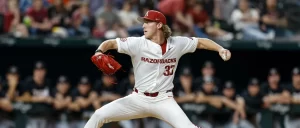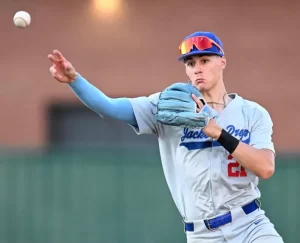Draft Preview: C Zack Collins – University of Miami

Zack Collins
School: University of Miami
Position: Catcher
Height/Weight: 6’3″, 220 lb
B/T: L/R
D.O.B: 2/6/1995
Previously Drafted: 2013, 27th (825) – CIN
2016 Stats: .381/.552/.645 (1.197 OPS) 8 2B, 11 HR, 51 RBI (51 games)
Scouting Reports:
“Collins is batting .425/.587/.726, ranking first in the nation in OBP. He’s a lefthanded hitter with plus power potential and a patient approach. Collins leads the nation with 48 walks, and his plate discipline has improved this season. Through his first 150 plate appearances, he drew 68 three-ball counts, according to Miami’s athletic communications department.” – Hudson Belinsky, Baseball America.
“While he has improved defensively, the jury is still very much out on whether he can stick behind the plate at the next level. He throws better than he did, though he still has a fringy average arm and he doesn’t move that well behind the plate. He can definitely hit, though, with a chance to put up 20-homer seasons annually. He has an advanced approach at the plate and isn’t afraid to take walks.” – MLB Pipeline.
“Collins has played 170 games in his college career, just over one full season in MLB notation, hitting a combined .321/.467/.593 with 36 doubles, 35 homers, 151 walks, and 141 strikeouts in 577 at-bats.
“Nobody thinks this is a metal bat fluke. Collins is universally praised for his hitting approach. His strike zone judgment is excellent and he has a combination of bat speed, selectivity, and aggression-when-needed that will stand him in good stead in pro ball. He should be expected to produce high on-base percentages and (at a minimum) above-average power. He probably won’t need much time to adjust to pro pitching and could get to the majors quickly on the strength of the bat.” – John Sickels, SB Nation
Scouting Grades:
Note: These grades are summations based on available scouting information from sources such as Baseball America, MLB.com, SB Nation, and Fangraphs.
(Present/Future, 20-80 scale)
Hit: 50/55
Power: 55/65
Run: 40/30
Arm: 50/60
Field: 40/50
Overall: 50/60
Prospect Overview and Future Outlook:
Zack Collins was a notable catching prospect back in high school but chose to attend the University of Miami, a natural choice for the Florida native. It’s paid dividends as Collins has refined his game and shot up draft boards as a result. He’s been knocking the cover off the ball all Spring and filling his draft balloon with more and more helium by the day, putting him in the top 10 conversation.
Collins will always be known as a bat-first player and questions remain whether or not he can stick at catcher, but the bat will play regardless. Collins feels like the type of player the White Sox have been missing for quite some time. He hits from the left-side and has a keen eye at the plate, as he’s second in the nation in OBP at the collegiate level and sports a 0.63 K/BB. Those are traits that have eluded past Chicago sluggers, and that’s the perfect word for Collins as he’s a potential middle of the order bat.
Patience at the plate helps Collins select the pitches he can truly drive. Pair this with his excellent bat speed and power-potent frame and you have yourself a dynamic power bat who could find himself with annual double-digit home run power. MLB Pipeline sees perennial twenty plus home run years as a possibility and his true ceiling likely sits around 25-30 HR.
That type of offensive season is always attractive, and two-fold when it has the chance to come from behind the plate. Although the million dollar question with Collins, likely the question that will determine the number of millions he gets, is whether or not he can stick behind the dish. Most scouting profiles think Collins has the arm to stay put, but not much else. MLB Pipeline questions his movements behind the plate, and he has halted only about 25 percent of base stealers this year. He’s not necessarily abysmal, as he only has two passed balls this year, but the general consensus is that he has poor mobility back there.
Obviously, Collins would be far more valuable behind the plate but the bat is strong enough to carry him regardless. The hit tool is advanced and he could potentially make a career as a first baseman or even designated hitter if need be. He has a little power projection left, but his run game will never be anything special. The natural comparison people are quick to make is Kyle Schwarber, another college catcher who could rake but has serious questions on defense. Collins’ bat could be expedited to the majors, not as quickly as Schwarber’s, but still quickly considering he’s already fairly polished. If the team that drafts him chooses to keep him behind the plate, then the bat won’t be rushed at the expense his defense and he’ll require at least a couple seasons in the minors.
Zack Collins the hitter has a decent ceiling to go along with a playable floor. Zack Collins the catcher and overall player has less of a floor, especially if a team has dreams of him as a future backstop.
Draft Day
Zack Collins didn’t look like a top ten pick at the start of the season; now he’s at least on the periphery. MLB Pipeline rates Collins as the 20th best prospect in the draft, Baseball America has him at 15th, while ESPN (Keith Law) has him at 29th. I think it’s wishful thinking to expect Collins to fall to the White Sox later in the round at 26th, so if they want him they’ll have to reach at ten.
The latest mock drafts around the game seem to agree he’s just on the edge of a top ten selection. Baseball America has him going to the Boston Red Sox at 12, MLB.com’s Jim Callis concurs, and ESPN’s Keith Law has him going to the Seattle Mariners at the pick immediately following Chicago’s.
There’s a good chance that Collins could be there for the picking at ten with the largest risk being the Oakland Athletics at number six, who Law says is eyeing a college bat.
It’s not the White Sox if we don’t mention a pitcher in the same sentence, and there will be college arms like Dakota Hudson available. Collins may not be the best player available, especially if a name like Blake Rutherford is still on the board, but he does represent a value play.
The White Sox could potentially sign Collins to an underslot deal and save some of their draft pool to get a premium player later in the first round. It’s an interesting strategy and would represent the team feeling fairly high on Collins sticking at catcher, a position the system is devoid of as of now. Either way, it’s a low risk pick considering his bat should keep him above water regardless of position. Collins may not be a top-ten-worthy selection if he can’t stay behind the plate, but if he can, he might be the biggest catch of the first round.
***Look for more profiles of potential draftees for the White Sox in the coming weeks before the draft***
Want to know right away when we publish a new article? Type your email address in the box and click the “create subscription” button. Our list is completely spam free, and you can opt out at any time.






